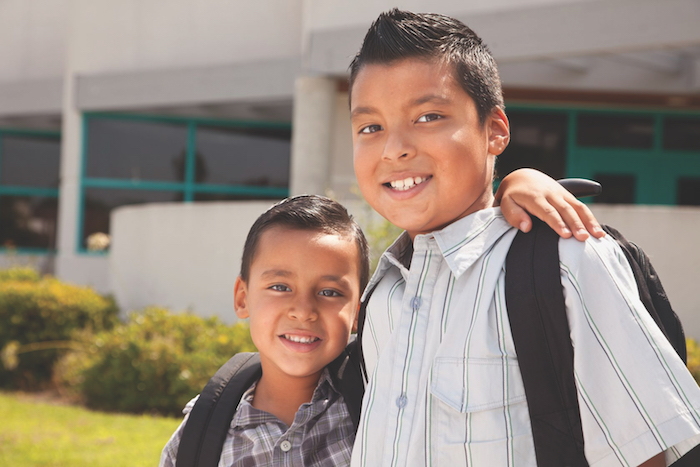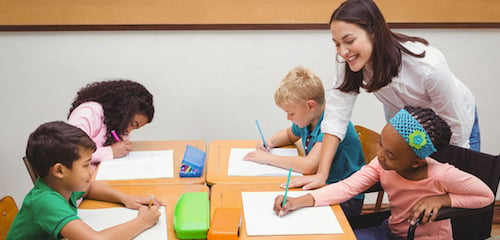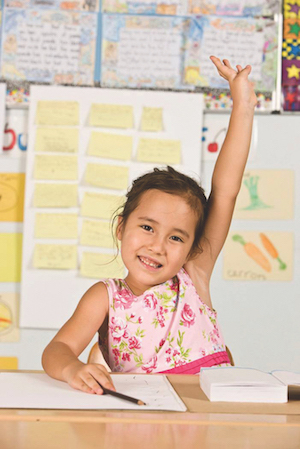
Making the Move from Preschool to Kindergarten
A Guide for Parents of 4- and 5-year-old Children Who Receive Preschool Special Education Services
When your child moves out of Early Childhood and Preschool Special Education services into kindergarten in an elementary school, it can be both challenging and exciting. Your child has been learning many skills in preschool. These skills will help your child to be successful in kindergarten. You can also help your child be prepared for kindergarten by following these tips.
During your child’s last year of special education preschool:
Gather information about school options for your child
- Ask your child’s preschool Individualized Education Program (IEP) case manager how to find the information you will need to enroll your child in kindergarten. Each school district does things a little differently, so it is important to have the right information for your family. A person at the Student Placement Center for your school district can explain how the enrollment process works. This person will tell you about important school choice activities and will let you know what the deadlines are for making your choices.*
- Find a special file or container, and use it to keep all the papers about kindergarten in one place.
- Learn more about parent roles, rights, and responsibilities in planning your child’s education. You may call PACER Center and ask to speak with a parent advocate. Somali, Southeast Asian, and Hispanic/Latino families may ask to speak with an advocate who speaks their language.
- Attend school information nights and open houses. You may wish to visit and observe possible schools and classrooms to see if the school is a good fit for your child.
- Meet with the IEP team to decide which school and classroom your child will attend in the fall. Ask for someone from the new school to attend a meeting in the spring to help plan the transition.
Enroll your child and learn about kindergarten at the new school

- Gather records and complete the forms needed to enroll your child in kindergarten at the new school. Find out what immunizations your child will need to have before school begins.
- Talk with the preschool teacher about ways to prepare your child for the transition to kindergarten.
- If English is not your first language, ask the preschool or district staff for help. They can find a person at the new school who can help you understand the information.
- Visit the new school. Attend Kindergarten Roundup.
- Ask for a student handbook, school calendar, and newsletter to help you become familiar with the school. Check for school community events that you may be able to attend with your child, such as a school carnival.
- Meet the principal and introduce your child. Ask about what other support staff are available at the school to help you and your child.
During the summer before kindergarten begins:
- Several weeks before school starts, begin bedtime, morning, and mealtime routines that will fit with the new school schedule.
- Help your child become more independent by offering acceptable choices, such as “Would you like to wear your blue shirt or your red shirt today?”
- If possible, walk or drive to the new school building to play on the playground.
- Practice walking to the bus stop or to school. Review safety rules.
- Practice kindergarten skills, such as stating first and last name, standing and walking in a line, waiting for a turn, and following a direction or rule for a game.
- Attend the school’s open house and orientation with your child. Arrange for your child to meet the teachers. Take photos of the school and classroom for your child. Talk with your child about the school day schedule and activities.
- Visit the local library and help your child get a library card. Participate in story time. Use the card to borrow a book each week. Include books about going to school. Some suggested titles are:
- Look Out Kindergarten, Here I Come, by Nancy Carlson; Available in Spanish: Preparate, Kindergarten! Alla voy!
- Kindergarten ABC, by Jacqueline Rogers
- The Kissing Hand, by Audry Penn
*Parents Need to Know
- In Minnesota, each public school is part of a school district. The district you live in is called your “resident district.” Many school districts have a “Welcome Center,” “Family Information Center,” or “New Families Center.” At the center, you can find out which schools your child may attend and how the school will provide transportation.
- You may request an interpreter and translated materials. You can also ask if there is a staff person who speaks your language.
- You may also want to learn about other school choice options, such as magnet and charter schools and open enrollment. Transportation may not be provided.
- Most children with an IEP will have the options all students have, including attending a neighborhood school within their attendance zone. Some children may have fewer school buildings to choose from because they need special programs most of the school day. The IEP team must find a school that can provide all the services and supports in the student’s Individualized Education Program. Parents are part of the IEP team.
Funded by the Minnesota Department of Education through the federal State Personnel Development Grant.
Planning for Your Child’s Transition to Kindergarten: A Timeline
When your child moves from Early Childhood Special Education services into kindergarten in an elementary school, it can be both exciting and challenging. Kindergarten is a big step in any child’s life. For a child with disabilities, being ready for that step often requires some intentional preparation. By working with your child’s Individualized Education Program (IEP) team, you can plan for your child’s success and make that first elementary school experience a good one.
One Year Before
Planning for your child’s entrance into kindergarten can begin as early as a year ahead of time. You can start the process by talking with the IEP team regarding your child’s strengths and weaknesses in various situations. You may want to discuss your child’s skills in the following areas:
- Social development
- Able to trust other adults and children
- Able to play with other children
- Able to learn and play in a group
- Emotional development
- Has some degree of independence and self-direction
- Has self-control or is learning to wait for things (even briefly)
- Is somewhat confident and willing to try new things
- Is interested in school and in learning new things
- Language development
- Able to understand directions
- Able to express needs
- Can express thoughts in sentences
- Has a reasonably broad vocabulary
- Can be understood by adults and other children
- Motor development
- Can run and jump
- Has self-help skills: dressing, eating, toileting
- Can copy simple symbols, numbers, and letters
- Can hold a pencil appropriately for writing
- Intellectual and academic development
- Able to focus and attend to an activity for 10-15 minutes
- Understands that letters stand for something
- Can follow simple directions and remember simple routines
- Able to stick with and solve simple problems
Discussing these areas will help you and the team think of goals that you might need to include in the IEP so your child will be prepared for kindergarten.

The Spring Before
In the spring before your child starts kindergarten, you can begin to consider specific school choices. Your IEP team can tell you about options for your child. Many districts assign children to a kindergarten in a specific school based on geographic location. Most schools have “kindergarten roundup/registration” events so families can learn about the kindergarten program. Plan to attend school information nights and open houses. You may wish to visit and observe possible schools and classrooms to see if the school is a good fit for your child. If you look at a school in the spring, remember that the children you observe are at the end of their school year, and their skills will be more advanced than those of a child just beginning kindergarten.
After you have completed any visits, plan to meet with your child’s IEP team to discuss which school your child will attend in the fall. Once you’ve made that decision, ask to schedule a “transition meeting” to meet a kindergarten teacher from that school and review your child’s IEP. During this meeting you and the rest of the IEP team can do the following:
- Write or review IEP goals and objectives
- Discuss how these goals will be implemented in the kindergarten environment
- Discuss any needed accommodations and modifications
- Instructional
- Building/safety
- Behavior
- Transportation
- Discuss your concerns regarding the transition
The Summer Before
Once the team has met and the IEP is revised as needed, it is time to think of ways to help prepare your child for this big step. Prior to the start of school, visit the classroom if you can, and explore the new school including the:
- Lunch room
- Bathrooms
- School office (principal)
- Playground
- Place where your child will be dropped off and picked up
Other ways to help your child be ready for school include:
- Making sure immunizations are up-to-date
- Taking pictures of the new school and classroom and using these pictures to talk about the transition over the summer
- Arranging summer playtimes with other students who may be in your child’s class
- Reading books with your child about kindergarten
- Practicing walking to the bus stop or to school
You may also want to work on skills such as:
- Stating first and last name
- Writing name, if appropriate
- Standing and walking in a line
- Waiting for a turn
- Following directions
- Following the rules of a game
- Building independence (using the bathroom, putting on a coat, tying shoes, etc.)
Before School Begins
Before school starts in the fall, you may wish to:
- Check with the team to make sure that all necessary equipment and accommodations listed in your child’s IEP are available in the classroom.
- Request a lunchroom menu and plan accordingly if your child has food allergies or sensitivities. Food allergies should also be discussed as part of a health plan with the school nurse.
- Make sure you know your child’s bus stop.
- Consider preparing a “snap shot” or short description of your child to share with the classroom teacher. To do so, order PACER’s free handout, “Introducing Your Child to the School Community Using a “Student Snapshot” Format (PHP-c160).”
A Time for Growth
Your child’s transition to kindergarten can be a positive experience by presenting both you and your child with new opportunities for growth and development. Transition is a process that happens over time and involves all the “stakeholders” (children, parents, preschool and Early Childhood Special Education teachers, childcare providers, kindergarten teachers, and maybe other family members as well). During this process, you will meet many people who will care about you and your child, and you will continue to have input into your child’s education. Remember that your input is extremely important because you are the expert on your child. Your opinions matter, so share them freely with the rest of the team. Being an active member of the IEP team is the best way to help your child be successful.
For more information on any concerns you have regarding the transition process, contact PACER and ask to speak with an early childhood advocate.
Are Extended School Year Services Right for Your Young Child?

Summer is a time for fun and sun. For some young children with disabilities, however, it can also be a time when important skills gained during the school year are lost. The three-month break from special education instruction and related services can mean that by September, some children have lost significant ground from their achievements in May.
For them, extended school year services may be a solution. Unlike summer school, extended school year services are tailored to the needs of the child and support goals established in the child’s Individualized Education Program (IEP). Designed to help children maintain their skill or development levels during long breaks, these services are provided at no cost to the family. They are for children with disabilities who are 3 to 21 years old and who have demonstrated the need for them.
Each year, your IEP team must discuss whether your child needs extended school year services. The team will look at several factors and compare them to the goals specified in your child’s IEP to determine if your child qualifies.
One factor the team will consider is called regression. “It means that when there’s a break in services, your child falls back to a significantly earlier skill level,” says Judy Swett, PACER’s early childhood advocate. “For example, before winter break, your child showed progress on a speech goal, such as using longer sentences. After winter break, he was back to using two word sentences.” Such changes should be documented by the team throughout the year, Swett adds. “This data is essential to determining if your child qualifies for extended school year services.”
A related consideration is called recoupment. It refers to how long it takes your child to regain the pre-break skill level. “It should not take longer to regain skills than the length of the break,” Swett says. Your child’s recoupment time should be documented as well.
Other factors will be considered, too. For example, would the break prevent your child from attaining or maintaining self-sufficiency skills that allow for personal independence? These skills typically are identified in your child’s IEP and may include such things as toileting, eating, dressing, manipulating objects, having impulse control, maintaining stable relationships with adults and children, and being able to communicate wants and needs.
As the team looks at your child’s potential need for extended school year services, they also will evaluate such things as:
- Rate of progress on a goal
- Impact of the break in service on emerging skills
- Goals on the child’s IEP that need continuous attention
After weighing all the data, the team will determine if your child qualifies for extended school year services. If so, the team will consider what services and settings would be best. Recommendations can range anywhere from a structured program at a school to community activities and suggestions of things the family can do at home. Some of the choices may include support from staff.
If your child does not qualify for services, you have other alternatives. You could, for example, ask your IEP team for suggestion of activities you can do with your child to maintain skills. If you can afford it, you also could hire a private therapist to provide services over the summer to work on individual skills.
Summer is indeed a time for fun and sun. For some children, it can also be a perfect time to keep skills sharp and give learning a great start in the fall.
